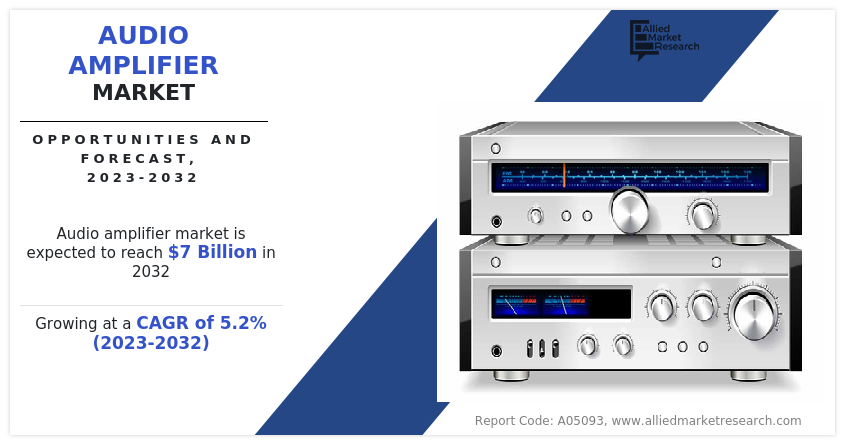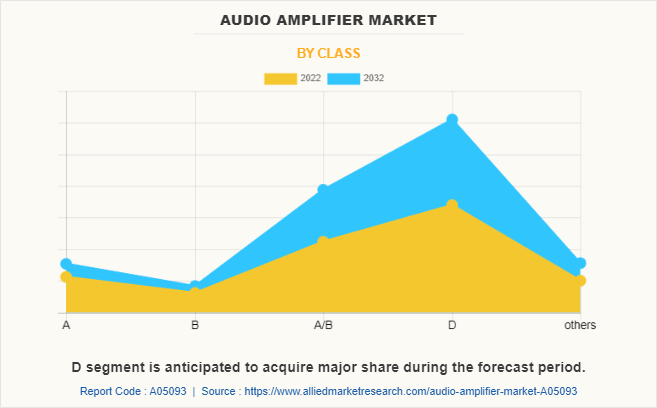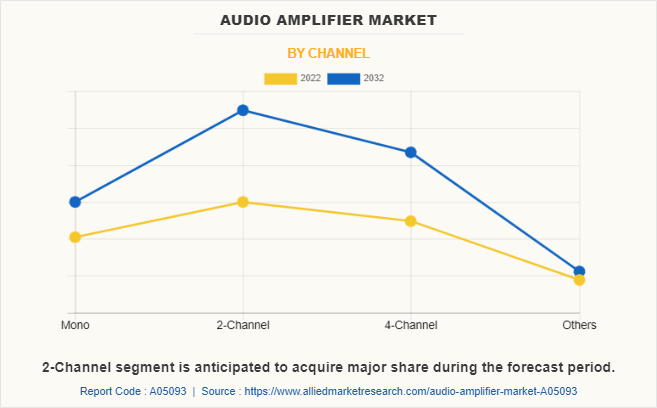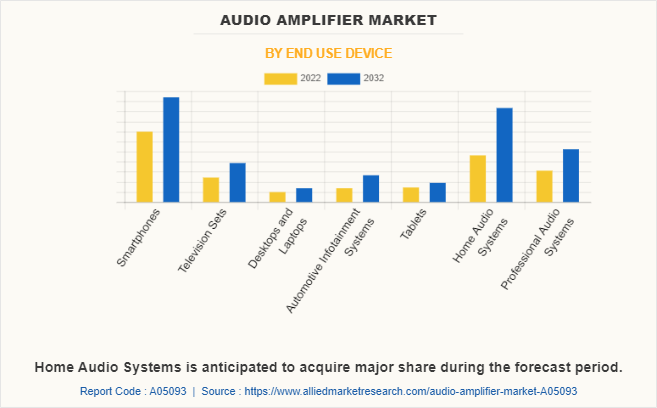Audio Amplifier Market Research, 2032
The global audio amplifier market was valued at $4.2 billion in 2022 and is projected to reach $7 billion by 2032, growing at a CAGR of 5.2% from 2023 to 2032.
One of the key factors driving the audio amplifier market growth is the Increasing demand for high-quality audio output. The necessity for powerful and efficient amplification becomes critical as customers become demanding and want immersive and quality audio experiences. Further, the growing need for crystal-clear sound, deep bass, accurate instrument separation, and dynamic range among end users creates significant revenue opportunities for high-quality audio amplifier providers.
Moreover, nowadays consumers expect rich and detailed audio output in their home theatre systems, professional sound systems, and portable audio devices. Thus, such needs encourage manufacturers to invest substantially in research and development and create sophisticated amplifying technologies capable of delivering higher sound quality output while minimizing distortion and noise. Furthermore, the emergence of high-resolution audio formats, as well as the popularity of streaming services offering high-quality audio content, fuels demand for audio amplifiers that can correctly replicate these formats.

An audio amplifier is an integrated circuit (IC) that is inserted in an electronic device and is used to increase the amplifier sound from a low-power electronic audio signal to a high-level audio signal. It is mostly used in sound systems such as home audio, musical instrument systems, loudspeakers, and sound reinforcement. The objective of an amplifier is to raise vibrations to the utmost extent of signals without changing frequency or wavelength and improve system efficiency.
There are various advantages to having an audio amplifier. Audio amplifiers provide amplification, which enables the regeneration of audio content at larger volume levels, making the content suited for big spaces, events, or personal listening preferences. Amplifiers also help increase the clarity and fidelity of audio signals by enhancing weak signals and reducing distortions or noise. The amplifiers not only supply the necessary power to drive the speakers, but they also help maintain the fidelity and quality of the sound, resulting in an enjoyable and impactful listening experience.
Moreover, audio amplifiers often come with various controls and features such as equalization, tone adjustment, and connectivity options, enabling users to customize the audio output as per their preferences and requirements.
Continuous technological advancements in the automotive and electronics sectors have enabled manufacturers to offer audio amplifiers powered with advanced features that can be easily connected with in-vehicle infotainment systems. Moreover, major automotive manufacturers are focused on equipping their vehicles with advanced audio systems incorporating audio amplifiers. This, in turn, increases the overall driving experience of commuters. For example, high-end automotive brands like Mercedes-Benz and BMW are known for equipping their vehicles with premium sound systems that incorporate advanced audio amplifiers to enhance the audio output. These amplifiers are designed to deliver powerful and clear sound, creating an immersive in-car entertainment experience for drivers and passengers. Thus, the surge in traction of in-vehicle infotainment systems is driving the growth of the audio amplifier market.
The increase in popularity of consumer electronic devices is another important driver for the audio amplifier market. As technology advances, people are adopting a wide range of electronic devices with expanded multimedia capabilities, such as smartphones, tablets, laptops, and smart speakers. These devices frequently include built-in speakers or headphone jacks, but their audio performance may fall short of the expectations of consumers who value high-quality music experiences. As a result, there has been an increase in demand for external audio amplifiers that may improve audio output and give higher sound quality. For example, many smartphone users enjoy listening to music, watching videos, or playing games on their devices. However, the built-in speakers of smartphones may not provide the desired audio quality and volume. As a result, consumers often opt for portable audio amplifiers that can significantly enhance the audio output of their smartphones, delivering richer, more immersive sound. These amplifiers can amplify the audio signal, improve clarity, and provide a better bass response, enhancing the overall listening experience.
On the other hand, competition from other technologies hinders the growth of the market. For instance, wireless audio solutions like Bluetooth speakers and smart speakers with built-in amplification capabilities have gained popularity among consumers for their convenience and ease of use. These technologies eliminate the need for separate audio amplifiers, which can pose a challenge to the traditional audio amplifier market. In addition, advancements in digital signal processing (DSP) technology have enabled manufacturers to enhance the audio quality and power output of devices without relying heavily on external amplification. This can also limit the demand for standalone audio amplifiers. As a result, audio amplifier manufacturers face the challenge of staying competitive and relevant in an evolving market where alternative technologies may offer comparable or even superior audio experiences.
Separately, the increasing popularity of audio-centric applications presents a significant future opportunity for the audio amplifier market in the coming year. There is a growing demand for high-quality audio reproduction with the rise of streaming platforms, podcasting, virtual reality, gaming, and home entertainment systems. These applications require power amplifiers that can deliver immersive sound experiences, precise audio reproduction, and sufficient power to drive speakers or headphones. For example, in the gaming industry, users expect highly immersive experiences with realistic audio effects, necessitating the usage of powerful audio amplifiers. Furthermore, spatial audio is heavily used in virtual reality applications to generate a sensation of presence, and audio amplifiers play an important part in delivering accurate and dynamic sound location. The growing popularity of audio tone amplifier applications in a variety of industries presents a lucrative potential for audio amplifier manufacturers to create specialized amplification solutions tailored to the specific needs of these applications.
Furthermore, the increase in the penetration of IoT is boosting the desire for the audio amplifier market. There is a growing need for audio amplifiers to enhance the audio capabilities of IoT devices as more devices become interconnected and capable of sharing and transmitting data. IoT devices such as smart speakers, connected audio systems, and voice-controlled assistants require audio amplifiers to deliver high-quality sound reproduction and ensure optimal audio performance. For example, smart speakers integrated with voice assistants like Amazon Echo or Google Home rely on audio amplifiers to produce clear and powerful sound output. Additionally, IoT devices in industrial settings, such as public address systems or audio communication systems in smart factories, require robust audio amplification for effective communication and broadcasting. The increasing integration of audio capabilities into IoT devices provides an opportunity for audio amplifier manufacturers to develop compact, energy-efficient, and technologically advanced amplifiers that can meet the demands of the IoT ecosystem.
Segment Overview
The audio amplifier market is segmented into Class, Channel, and End-use devices.
Based on class, the audio amplifier market outlook is divided into class A, class B, class A/B, class, and others. In 2022, the D-class segment dominated the market, in terms of revenue, and it is expected to acquire a major market share by 2032.

Based on channel, the audio amplifier market size is bifurcated into mono, 2-channel, 4-channel, and others. In 2022, the 2-channel segment dominated the market, in terms of revenue, and it is expected to acquire a major market share by 2032.

Based on end-use devices, the audio amplifier market forecast is segmented into smartphones, television sets, desktops & laptops, automotive infotainment systems, tablets, home audio systems, and professional audio systems. In 2022, the smartphone segment dominated the market, in terms of revenue, and home audio systems it is expected to acquire a major market share till 2032.

Region-wise, the audio amplifier market trends are analyzed across North America (the U.S., Canada, and Mexico), Europe (UK, Germany, France, and the rest of Europe), Asia-Pacific (China, Japan, India, South Korea, and rest of Asia-Pacific), and LAMEA (Latin America, Middle East, and Africa).. In 2022 the Asia-Pacific audio amplifier market share is expected to grow at the highest CAGR during the forecast period, owing to the increased investments in consumer electronics and automotive industries, majorly in central and southern regions.

Competitive Analysis
The key players profiled in the report include STMicroelectronics, NXP Semiconductors, Analog Devices, Yamaha Corporation, ON Semiconductor, Texas Instruments, Kenwood Corporation, Cirrus Logic, Infineon Technologies, Qualcomm Incorporated. These key players have adopted strategies, such as product portfolio investments, expansion, and product launches to enhance their position in the audio amplifier market.
Historical Data & Information
The audio amplifier industry is highly competitive, owing to the strong presence of existing vendors. Vendors in the audio amplifier market with extensive technical and financial resources are expected to gain a competitive advantage over their competitors as they can cater to audio amplifier market demands. The competitive environment in this market is expected to increase owing to technological innovations, product extensions, and different strategies adopted by key vendors.
Key Developments/ Strategies
- In March 2023, Analog Devices (ADI) launched a new uModule regulator designed to power noise-sensitive applications with exceptional performance. The ADI module regulator offers ultra-low noise and ultra-high power supply rejection ratio (PSRR), making it ideal for applications that require precise and clean power. This regulator provides an integrated solution with reduced design complexity and offers superior performance, ensuring reliable and efficient power delivery for noise-sensitive devices and systems.
- In January 2023, Yamaha Corporation launched a new 2000 Series Hi-Fi system, which includes a network receiver and matching speakers. This premium audio setup combines exquisite design with advanced technology to deliver an exceptional listening experience. The network receiver offers versatile connectivity options, including Wi-Fi, Bluetooth, and support for various streaming services, allowing users to easily access and enjoy their favorite music. The matching speakers are crafted to deliver pristine sound quality with precision and clarity. With the 2000 Series Hi-Fi system, Yamaha aims to provide audiophiles and music enthusiasts with a visually appealing and high-performing audio solution that enhances the enjoyment of their music collection.
- In January 2023, Infineon Technologies launched a new product called INFPSS202301-051, which is a high-performance silicon microphone designed to enable clear and precise voice capture in various applications. This silicon microphone leverages Infineon's advanced MEMS technology and features a small form factor, low power consumption, and high signal-to-noise ratio. With its exceptional performance and reliability, the INFPSS202301-051 microphone is suitable for use in applications such as smartphones, smart speakers, wearables, and IoT devices, where high-quality voice capture is crucial.
- In February 2022, Infineon Technologies AG launched the MERUS 2-channel, analog input, class D audio amplifier multichip module MA5332MS. It is a powerful upgrade to its predecessor, offering the same or even higher output power than monolithic alternatives, without a heatsink and 50 percent less footprint. In the 100-400 W/channel range, MA5332MS is ideal for consumer products including home theaters in a box, soundbars, subwoofers, and mini-component systems. It is also well suited for professional applications like active speakers, active studio monitors, guitar amplifiers, aftermarket cars, and marine audio amplifiers.
Key Benefits for Stakeholders
- This report provides a quantitative analysis of the audio amplifier market segments, current trends, estimations, and dynamics of the audio amplifier market analysis from 2022 to 2032 to identify the prevailing audio amplifier market opportunity.
- The market research is offered along with information related to key drivers, restraints, and opportunities.
- Porter's five forces analysis highlights the potency of buyers and suppliers to enable stakeholders to make profit-oriented business decisions and strengthen their supplier-buyer network.
- An in-depth analysis of the audio amplifier market segmentation assists in determining the prevailing market opportunities.
- Major countries in each region are mapped according to their revenue contribution to the global market.
- Market player positioning facilitates benchmarking and provides a clear understanding of the present position of the market players.
- The report includes an analysis of the regional as well as global audio amplifier market trends, key players, market segments, application areas, and audio amplifier market growth strategies.
Audio Amplifier Market Report Highlights
| Aspects | Details |
| Market Size By 2032 | USD 7 billion |
| Growth Rate | CAGR of 5.2% |
| Forecast period | 2022 - 2032 |
| Report Pages | 325 |
| By End use Device |
|
| By Class |
|
| By channel |
|
| By Region |
|
| Key Market Players | Yamaha Corporation, Analog Devices, Inc., STMicroelectronics N.V., NXP Semiconductors., Infineon Technologies AG, Qualcomm Technologies, Inc. , Cirrus Logic, Inc., ON Semiconductor Corporation, JVCKENWOOD Corporation, Texas Instruments Incorporated |
Analyst Review
The global audio amplifier market holds high potential for the semiconductor industry. The business scenario witnesses an increase in the demand for audio amplifier devices, particularly in developing regions, such as China, India, U.S., UK, and others. Companies in this industry have been adopting various innovative techniques to provide customers with advanced and innovative product offerings.
The increase in demand for high-quality audio output and growth in traction of in-vehicle infotainment systems in the audio amplifier market drive the growth of the market. However, the integration of audio amplification in consumer electronic devices impedes market growth. Moreover, an increase in IoT penetration is expected to create lucrative opportunities for the key players operating in the market during the forecast period.
The market participants are expected to introduce technologically advanced products to remain competitive in the market. Product launch and collaboration are the prominent strategies adopted by the market players. For instance, in December 2022, STMicroelectronics launched FDA803S and FDA903S, which are the newest single-channel fully differential 10W Class-D audio power amplifiers in the STMicroelectronics fully digital amplifier (FDA) family. They are designed for automotive applications like eCall, telematics, and wherever an audio channel needs to reproduce human voice, music, or warning messages at a standard output power level of up to 10W.
Increase in demand for high-quality audio output, growing traction of in-vehicle infotainment systems and increase in popularity of consumer electronic devices are the upcoming trends of audio amplifier market in the world
Home audio systems, automotive sound systems and others are the leading application of audio amplifier market.
Asia-Pacific is the largest regional market for audio amplifier
The global audio amplifier market was valued at $4,195.06 million in 2022.
STMicroelectronics, NXP Semiconductors, Analog Devices, Yamaha Corporation, ON Semiconductor, Texas Instruments, Kenwood Corporation, Cirrus Logic, Infineon Technologies, Qualcomm Incorporated are the top companies holding a prime share in the global audio amplifier market.
Loading Table Of Content...
Loading Research Methodology...


